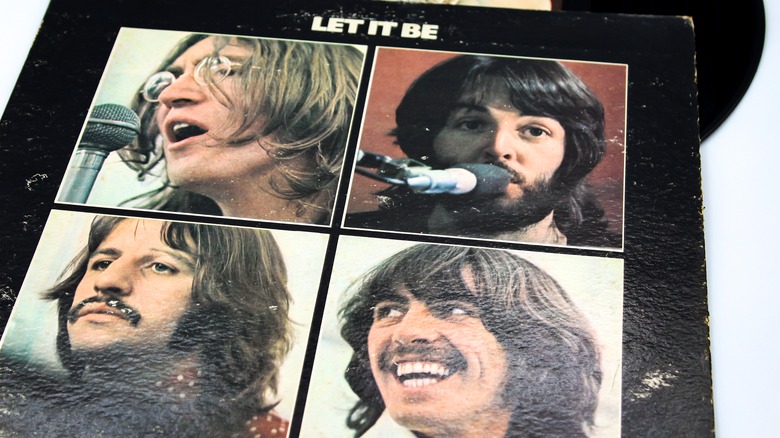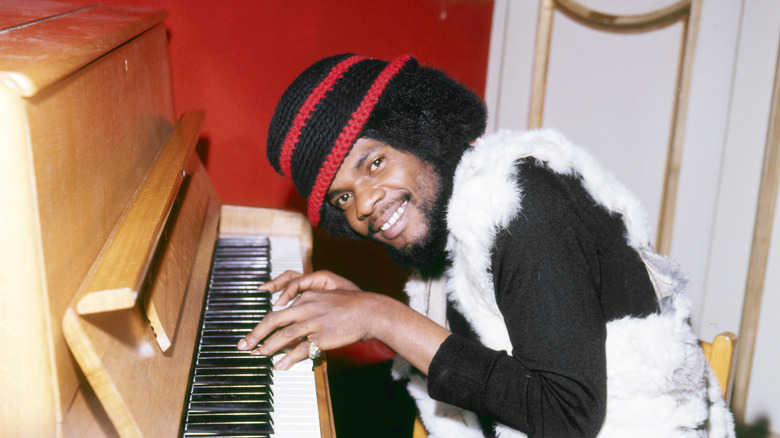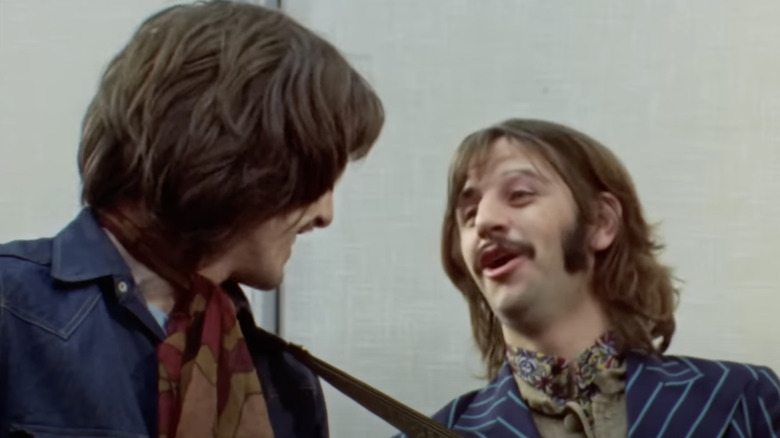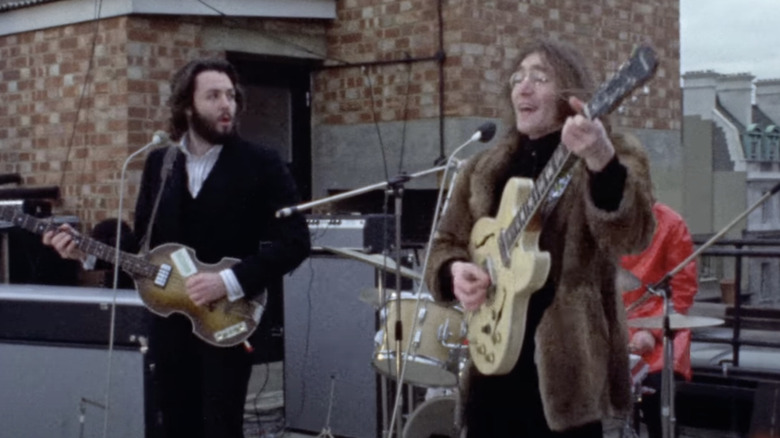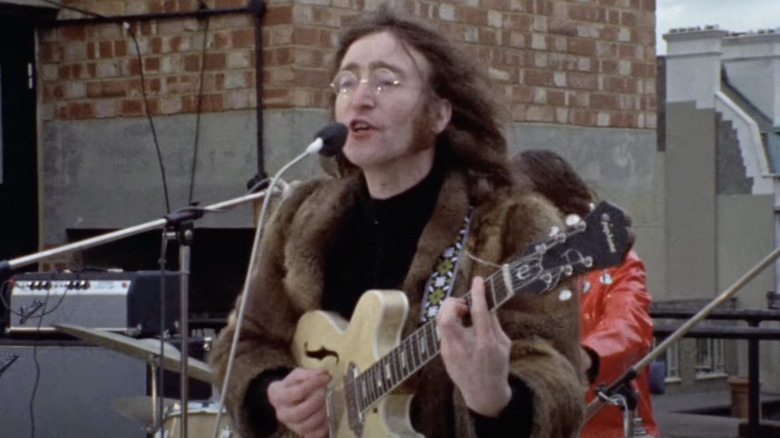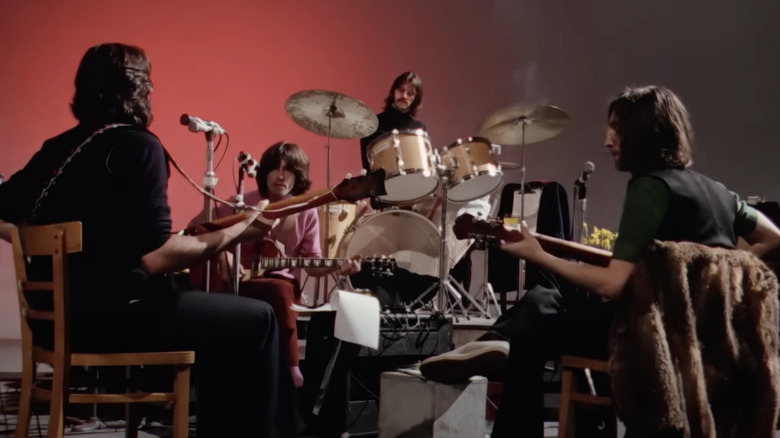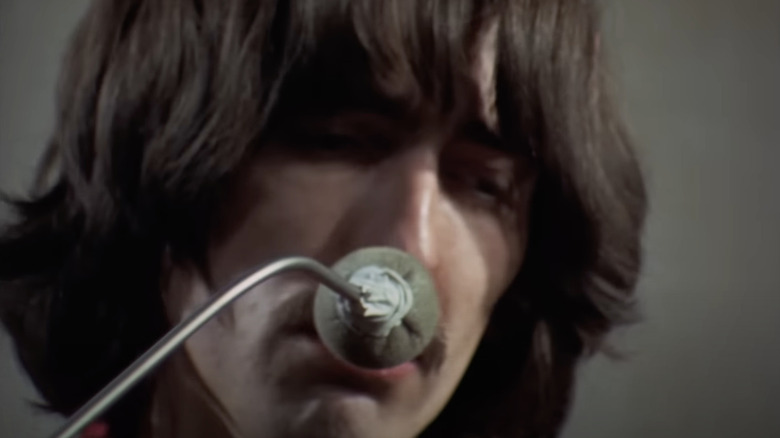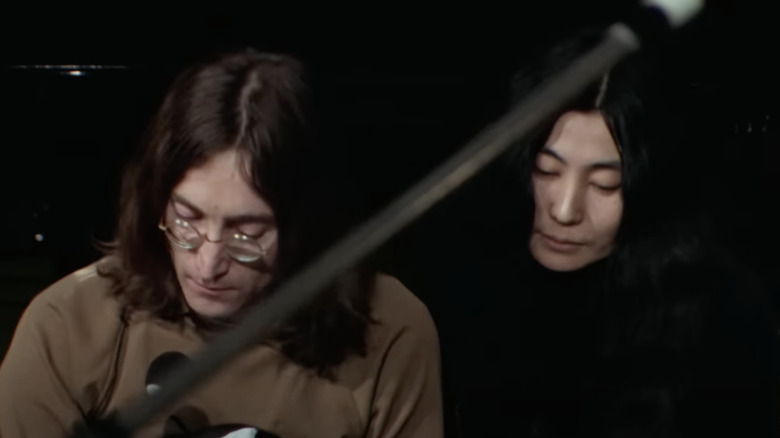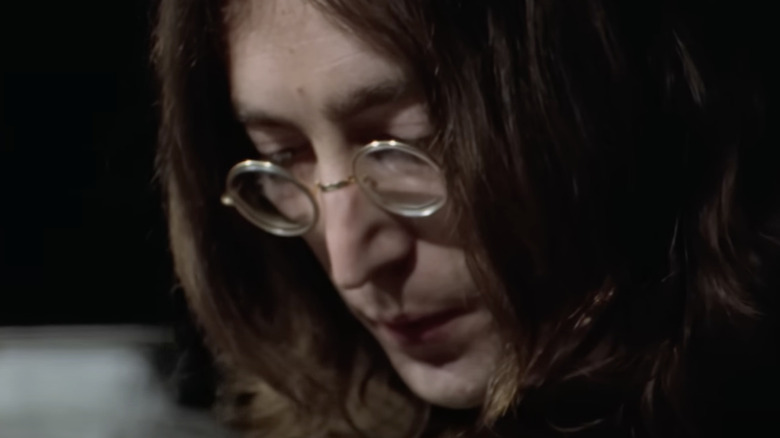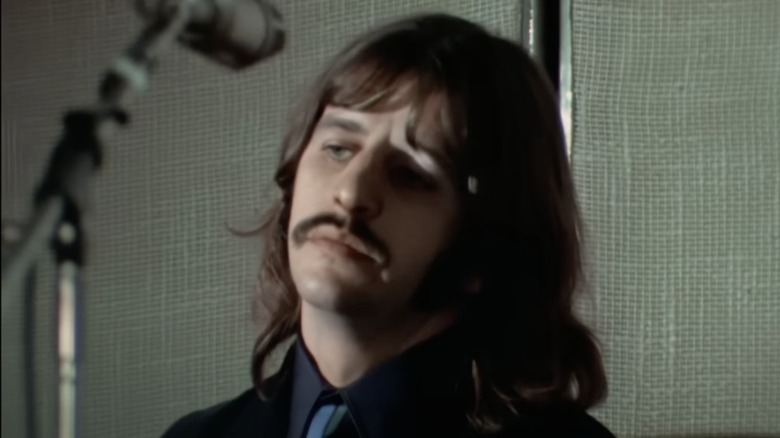Things The Beatles 'Let It Be' Documentary Left Out Of The True Story
In 1970, the Beatles starred in the documentary film "Let It Be," which captured the process of working through and performing the songs that would appear on one of its last albums, also called "Let It Be." The documentary was briefly available on home video in the 1980s and disappeared until 2024, when a restored and remastered version arrived on Disney+, a project overseen by filmmaker Peter Jackson after compiling the nearly eight-hour docu-series "Get Back," which examines the same pivotal time in the history of the Beatles.
Part of the untold truth of the Beatles is the complicated situation surrounding the Fab Four's final bursts of creativity, including "Let It Be." The documentary takes place over the span of a few weeks in January 1969, when the Beatles decamped to two rehearsal spaces to write and rehearse new songs, before performing them live on the rooftop of its corporate headquarters in London. The documentary consists of fly-on-the-wall style rehearsal footage and then the performance itself — the Beatles' final show together as a foursome. The casual, unadorned "Let It Be" leaves out so much of the story of the Beatles in 1969, a creatively fruitful time but also one that would see the band irrevocably falling apart. Here's everything the "Let It Be" documentary didn't explain about the last days of the Beatles.
The impact and importance of Billy Preston joining the Beatles
About halfway through "Let It Be," as the Beatles continue to write, rehearse, and wrestle with new songs in advance of the band's first concert in nearly three years, they start playing through some old rock n' roll favorites. During a run-through of "You Really Got a Hold On Me," there's suddenly another musician present, jamming with the band and assisting on various key-based instruments. That's Billy Preston.
Billy Preston spent a lot of time working with the Rolling Stones after the Beatles, but he isn't even identified, singled out, or acknowledged in "Let It Be." Beatle fans might know who he is because of his official crediting by name on the release of single "Get Back" in 1969, created during the period of filming on "Let It Be," which overlooks and understates the importance of the multi-instrumentalist. The Beatles knew the musician from its early days playing in Hamburg, Germany, and George Harrison brought him in during the sessions for what would become the "Let It Be" album to inject new energy into the band and flesh out its sound as it prepared to perform live.
The band was on its last legs, and Preston brought so much energy and newness into the band that they even considered adding him as a permanent member. Instead, he just played on "Get Back" and with the Beatles at its rooftop concert seen in "Let It Be."
The Beatles rehearsed a lot more songs than shown on screen
The "Let It Be" documentary consists almost entirely of unadulterated, narration-free footage of the Beatles recording and rehearsing in Twickenham Film Studios, and then at its own Apple Corps building, before taking to the roof of that London facility for what is presented as an impromptu or guerilla concert. The songs that the Beatles rehearse inside, and then perform outside, would later populate the 1970 album "Let It Be." Later standouts from that record are all over the "Let It Be" documentary in various permutations, including "The Long and Winding Road," "Get Back," and "Across the Universe," as well as "Abbey Road" tracks like "Maxwell's Silver Hammer and "Octopus's Garden."
Because it's depicted in "Get Back," the eight-hour 2021 documentary made from the same source footage as "Let It Be," there's film of the Beatles rehearsing other "Let It Be" and "Abbey Road" tunes, as well as dozens of others during this same concert rehearsal period. Among the songs that didn't make it into the 1970 "Let It Be" are the Beatles playing around with the Liverpool folk song "Maggie Mae" and working through early versions of future classics "Something," "Mean Mr. Mustard," "Polythene Pam," "She Came in Through the Bathroom Window," and "Carry That Weight."
The rooftop concert was a lot longer
On January 30, 1969, the Beatles played a 42-minute concert on the roof of its own Apple Corps building on Savile Row in London, playing nine takes of five new songs. The "Let It Be" documentary, which builds up to and climaxes to this performance, doesn't even include the entirety of the concert — which is the Beatles' final public performance and also something of another rehearsal session for songs they'll eventually record.
The concert takes up only about 20 minutes of screen time in "Let It Be," and the film presents six distinct songs: "Get Back," "Don't Let Me Down," "I've Got a Feeling," "One After 909," "Dig a Pony," and then another crack at "Get Back." The documentary leaves out a large portion of this important moment in Beatles history by way of excising several songs. Not included in "Let It Be" are another take on "Get Back," other versions of "Don't Let Me Down" and "I've Got a Feeling," attempts at "A Pretty Girl is Like a Melody" and "Danny Boy," and a special Beatles-arranged, free-form rendition of the U.K.'s national anthem, "God Save the Queen."
The rooftop concert almost didn't happen
It was George Harrison who nixed the original concept of "Let It Be" as a full-fledged televised concert special, but Paul McCartney had suggested a willingness to do some kind of live performance element in the project, which led to the rooftop idea. When the climactic moment finally arrives in "Let It Be," it's treated by the filmmakers and the Beatles as a mundane, routine act.
After rehearsing and playing in a practice space together for many days, they seemingly all get up, head up to the roof and spontaneously play a series of brand-new songs on their equipment that's all been laid out, tuned, and ready to go. It all unfolds like a foregone conclusion, when in fact, the rooftop performance was only somewhat planned, and also somewhat impromptu.
In a present-day produced prologue to the film, director Michael Lindsay-Hogg mentions that he originally intended "Let It Be" to be a concert film, not a rehearsal documentary, and he wanted to shoot a day-long show in a large theater. Expectations scaled down over time to where a rooftop concert was suggested, of which the Beatles remained noncommittal and unmoved until the moment before they picked up their instruments before John Lennon gave it the go-ahead. Unable to come to a decision as a group, Lennon said, "'F*** it — let's go do it,'" Lindsay-Hogg recalled in "The Beatles: Get Back" book.
The rehearsals were supposed to generate a live album
While documentaries are by their nature educational, and each serves a purpose, "Let It Be" never quite explains its premise of the reason for its existence. The remastered, 2024 edition opens suddenly with a conversation between director Michael Lindsay-Hogg and restorer Peter Jackson, noting that the film consists of rehearsal footage for a live show, and the documentary gets underway with the Beatles playing songs at Twickenham Film Studio. After that, the group rehearses at its Apple Corps building, and then they perform on a roof, playing primarily the songs that would comprise the bulk of the 1970 studio album "Let It Be." Not ever clearly mentioned in the documentary is how the project was briefly titled "Get Back," after one of the songs created in the depicted sessions, and also a thesis statement about how the increasingly fracturing Beatles wanted to return to a stripped-down, classic rock n' roll sound.
The documentary never makes it fully clear that the songs the Beatles rehearse are the ones they're virtually writing simultaneously. For example, Paul McCartney workshops "Get Back" in front of the cameras. Nor does "Let It Be" let on that the rooftop concert was an alternative to the initial, ambitious goal of the project. Before filming and recording began, the Beatles were supposed to perform in a large venue, such as the Sabratha Amphitheater in Libya.
George Harrison left the Beatles
One event in the tragic real-life story of George Harrison: His brief exit from the Beatles in 1969. All the cameras and microphones around the Beatles' recording and rehearsal spaces in 1969 that provided the raw footage for "Let It Be" must have captured that moment, which helped explain the break-up of the Beatles a year later. There just wasn't room in the documentary's format of wall-to-wall music to discuss or show Harrison's departure. Harrison's decision to quit was born out of the musician questioning his talents as a guitarist and feeling like he wasn't getting much out of the group anymore. So, one day, when the group took a lunch break, Harrison announced he was done, went home, and didn't come back.
The group, along with Yoko Ono, ultimately pleaded for Harrison to return, and after he took some time off with a trip to his hometown of Liverpool, he did rejoin the Beatles. However, it was with some caveats. The reason why the action in "Let It Be" switches abruptly from an eerily lit TV studio to a bright, white, well-appointed rehearsal space was at Harrison's insistence. He felt more comfortable rehearsing at Apple Corps than Twickenham Film Studios, and he wanted to focus on the album and move away from the concert angle, thus explaining the move.
The Yoko Ono factor
One of the myths you can stop believing about the Beatles: that Yoko Ono actively tried to split up the group. By 1969, John Lennon had fallen in love with and become engaged to Ono, also becoming an acolyte of the experimental artist. What Yoko Ono's relationship with the Beatles was really like was more complicated than that. She was a big presence in Lennon's life during the filmed recording and rehearsal sessions that would become "Let It Be," and was apparently physically in the room at the time, too.
Her face briefly pops up on screen a handful of times in the documentary, belying her true and full influence on the Beatles at the time. "Let It Be" was made from the same footage as "The Beatles: Get Back," and that fuller depiction of the "Get Back" sessions (which produced the "Let It Be" album) demonstrates that Ono was just hanging around a lot, not contributing to the music or the creative direction of the band but rather hanging out with her husband while she knitted, read, and rolled cigarettes.
Paul McCartney and John Lennon were at odds
From the plethora of footage of John Lennon and Paul McCartney happily jamming with each other throughout the "Let It Be" documentary, it's hard for viewers to detect much tension. But this film was produced in early 1969, and the Beatles would be split up forever a little over a year later. Suffice it to say, there were a lot of creative and personal disagreements going on in the band, particularly between Lennon and McCartney.
As shown in "Let It Be," they kept up a solid and professional working relationship to get the task at hand done, but they were individually and collectively bristling at life in the Beatles. In "The Beatles: Get Back," McCartney discusses feeling like the band's director, while Lennon appears increasingly distant and aligns himself with his new partner, artist Yoko Ono.
Some of these concerns were addressed in what McCartney and Lennon thought was a private conversation. "Let It Be" documentary filmmaker Michael Lindsay-Hogg hid microphones all over the studio facility, including a cafeteria table, to record otherwise off-the-record talks. One such moment is shown in the documentary "The Beatles: Get Back," where Lennon and McCartney commiserate over the departure of George Harrison, and how it may not be something the band can withstand. McCartney also hints at the growing resentment over Ono, and he correctly predicts that someday, fans will blame her for the band's eventual split. "They broke up because Yoko sat on an amp," he quips.
The album took a year to get released
Clearly, the 1970 documentary "Let It Be" was a product tie-in linked to the release of the 1970 Beatles album "Let It Be," named after the regal ballad primarily composed and performed by Paul McCartney that appears in both media. However, when the project was being planned and being produced, it didn't have a name. About three months after the climactic rooftop concert captured in "Let It Be" the movie, the Beatles released the first single from the sessions, "Get Back," which engineer Glyn Johns proposed as the title of the forthcoming album.
The Beatles declined to use that name, nor did they even finish or release the album at hand right away. In mid-1969, the group got to work on "Abbey Road," from which some tracks were created during the filming of "Let It Be." That record hit stores in the fall of 1969, and only in 1970 — and after the departure of John Lennon — did the Beatles wrap up work (and title) "Let It Be" the album. This makes "Let It Be" the last studio album released by the Beatles before its 1970 split, but not entirely the last one that the band recorded.
